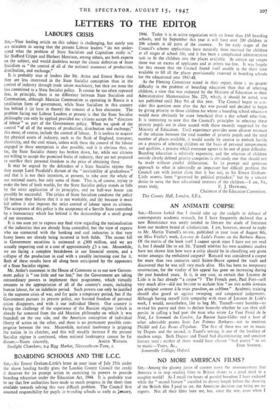AN ANIMATE CORPSE
Sue,—Heaven forbid that I should take up the cudgels in defence of contemporary academic research, for I have frequently declared that a new Renaissance was sorely needed to liberate the study of literature from our modern brand of scholasticism. I am, however, moved to reply to Mr. Martin Turnell's review, published in your issue of August 8th, on Miss Fairlie's work, Leconte de Lisle's Poems on the Barbaric Races. Of the merits of the book itself I cannot speak since I have not yet read it, but I should like to ask Mr. Turnell whether his own academic studies have not shown him how wary a critic should be in classifying any given writer amongst the embalmed corpses? Ronsard was considered a corpse for more than two centuries until Sainte-Beuve opened the vault and discovered that he was still very much alive. His has been no temporary resurrection, for the vitality of his appeal has gone on increasing during the past hundred years. Is it, in any case, so certain that Leconte de Lisle is in fact already "a corpse "? The French poet, Paul Fort—still very much alive—did not hesitate to acclaim him " un tris noble icrivain qui atteignit souvent a la vraie grandeur, au sublime." Academic training should also guard us against sweeping and categorical judgements. Although having myself little sympathy with most of Leconte de Lisle's work, I would, nevertheless, like to beg Mr. Turnell—very humbly—to re-read his poetry and then to declare honestly whether he can then still persist in calling a bad poet the man who wrote Le Vent Froid de la Nuit, Le Sommeil du Condor, La Ravine Saint-Gilles and a host of other admirable poems from Les Poimes Barbares—not to mention Phidile and Les Roses d'Ispahan. The first of these was set to music by Duparc and the second, in Faure's setting, is one of the loveliest of modern songs. Both Duparc and Faure had discriminating and sensitive literary taste ; neither of them would have chosen " had poetry " to set


































 Previous page
Previous page